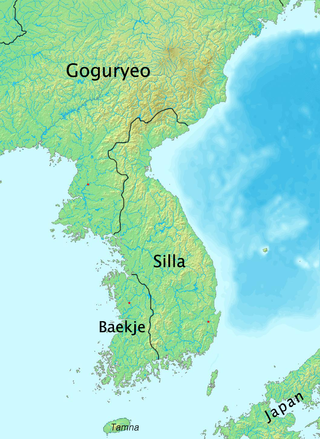
Hanja, alternatively known as Hancha, are Chinese characters used to write the Korean language. After characters were introduced to Korea to write Literary Chinese, they were adapted to write Korean as early as the Gojoseon period.

Silla, was a Korean kingdom that existed between 57 BCE – 935 CE and was located on the southern and central parts of the Korean Peninsula. Silla, along with Baekje and Goguryeo, formed the Three Kingdoms of Korea. Silla had the lowest population of the three, approximately 850,000 people, significantly smaller than those of Baekje and Goguryeo.
HD Hyundai Heavy Industries Co., Ltd. is the world's largest shipbuilding company and a major heavy equipment manufacturer. Its headquarters are in Ulsan, South Korea.

The prime minister of the Republic of Korea is the deputy head of government and the second highest political office of South Korea who is appointed by the President of the Republic of Korea, with the National Assembly's approval. The prime minister may be a member of the National Assembly, but this is not required to hold the office. The prime minister of South Korea is not the head of government of South Korea, for the President is both the head of state and government in the country.

Radical 212, 龍, 龙, or 竜 meaning "dragon", is one of the two of the 214 Kangxi radicals that are composed of 16 strokes. The character arose as a stylized drawing of a Chinese dragon, and refers to a version of the dragon in each East Asian culture:
Parastenolechia is a genus of moths in the family Gelechiidae.

Ganggangsullae (Korean: 강강술래) is an ancient Korean dance that was first used to bring about a bountiful harvest and has developed into a cultural symbol for Korea. It incorporates singing, dancing, and playing and is exclusively performed by women. The dance is mostly performed in the southwestern coastal province of South Jeolla Province. It is often associated with the Chuseok holiday and Daeboreum and is performed when the full moon rose above the mountains They dance all night and continue to play folk games in circles. The performance starts with a late Ganggangsullae and changes to a 'Jajeun-Ganggangsullae', which are characterized by the most beautiful and feminine charms of late Ganggangsullae, and 'Jung-Ganggangsullae" only in the Haenam and Jindo provinces.

Radical 181 or radical leaf (頁部) meaning "leaf", "head" or "page" is one of the 11 Kangxi radicals composed of 9 strokes.

Radical 185 or radical head (首部) meaning "head" is one of the 11 Kangxi radicals composed of 9 strokes.
Batrachedra albicapitella is a moth in the family Batrachedridae. It is found in Russia, Korea and Japan.
Parastenolechia acclivis is a moth of the family Gelechiidae. It is found in northern Vietnam.
Parastenolechia suriensis is a moth of the family Gelechiidae. It is found in southern and central Korea.
Parastenolechia argobathra is a moth of the family Gelechiidae. It is found in Korea, Japan, the Russian Far East and China.
Parastenolechia claustrifera is a moth of the family Gelechiidae. It is found in China (Zhejiang) and Taiwan.
Parastenolechia issikiella is a moth of the family Gelechiidae. It is found in Japan and Korea.
Parastenolechia superba is a moth of the family Gelechiidae. It is found in Korea and the Russian Far East.
Parastenolechia collucata is a moth of the family Gelechiidae. It is found in Korea and the Russian Far East.
Parastenolechia formosana is a moth of the family Gelechiidae. It is found in Taiwan.
Parastenolechia gracilis is a moth of the family Gelechiidae. It is found in Taiwan.

Parastenolechia nigrinotella is a moth of the family Gelechiidae. It is found in Turkey, on Sicily and in Spain, France, Italy, Austria, the Czech Republic, Slovakia, Croatia, Hungary, Romania, Bulgaria, North Macedonia and Greece.







